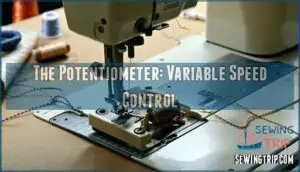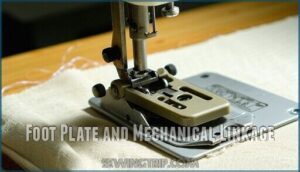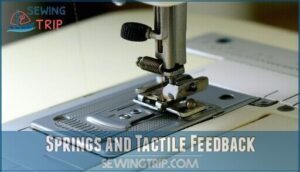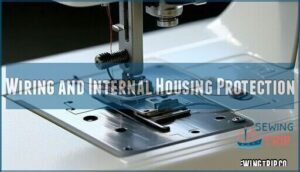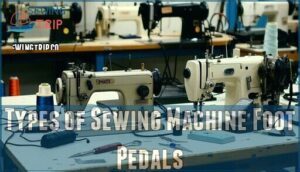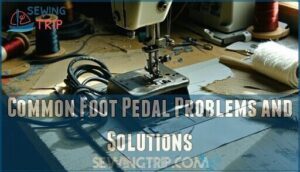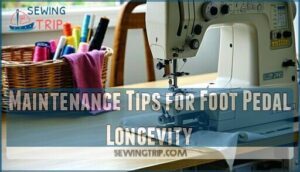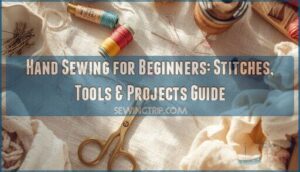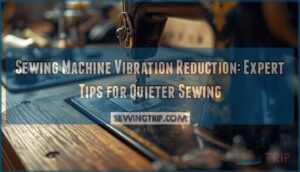This site is supported by our readers. We may earn a commission, at no cost to you, if you purchase through links.
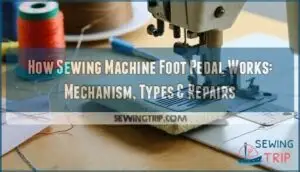
Inside that unassuming plastic case sits a deceptively simple circuit: a variable resistor that throttles electrical current like a dimmer switch controls light intensity. Most sewists take this instant responsiveness for granted—until the pedal stops working. Stuck at full speed, unresponsive, or delivering erratic bursts, it turns straight seams into wobbly disasters.
Understanding how your foot pedal regulates power flow reveals why these failures happen and, more importantly, how to diagnose and fix them before your next project deadline.
Table Of Contents
Key Takeaways
- Your sewing machine foot pedal works by using a variable resistor (rheostat or potentiometer) that decreases electrical resistance as you press down, allowing more current to flow to the motor and increasing stitch speed with precise, pressure-sensitive control.
- Most pedal failures stem from three fixable issues: worn or dirty carbon disks in vintage models, frayed wiring and loose connections (causing 70% of malfunctions), or stuck mechanical components like broken springs and jammed linkages.
- Regular maintenance dramatically extends pedal lifespan—clean moving parts, lubricate linkages, inspect carbon disks without touching their surfaces, check electrical connections for corrosion, and store pedals in dry spaces with loosely coiled cables to prevent wire fractures.
- Pedal compatibility isn’t universal across machines because voltage, amperage, plug configuration, and analog versus digital circuitry all vary by manufacturer, so always verify specifications before replacing or adapting a foot control to avoid motor damage.
How a Sewing Machine Foot Pedal Works
Your sewing machine foot pedal isn’t just a simple on-off switch—it’s a precision control system that translates the pressure of your foot into variable motor speed. At its heart lies an elegant interplay between electrical resistance and current flow, giving you the power to stitch at exactly the pace you need.
So how does this crucial part actually function? It starts with understanding the basic electrical principles at work.
Electrical Current and Resistance Regulation
When you press down on that foot pedal, you’re not just controlling speed—you’re actually becoming part of an electrical circuit that regulates how much current flows into your machine’s motor. Think of it like a gate: when you push harder, resistance drops and electrical signals surge through, powering up the motor.
Release pressure, and resistance regulation kicks in, choking off current flow until the machine stops. This variable resistor principle—whether it’s a rheostat or potentiometer acting as your variable power controller—is what gives you that precise control over circuit safety and power regulation.
Role of The Rheostat or Potentiometer
The component doing this work is either a rheostat or potentiometer—both variable resistors that convert foot pressure into electrical changes, just through slightly different mechanisms.
Here’s what makes them control your speed:
- Voltage management shifts dynamically as resistance changes with each millimeter of pedal travel
- Current flow increases proportionally when you depress the foot pedal mechanism further
- Electrical resistance decreases systematically, giving your variable power controller its responsive feel
Think of it as the conductor of your machine’s electrical orchestra.
Translating Foot Pressure Into Speed Control
Your foot becomes the conductor’s baton in this electromechanical performance, and every subtle shift in pressure orchestrates an immediate change in your machine’s motor speed.
The foot pedal mechanics translate physical force into electrical signals through the potentiometer, where pedal dynamics create real-time speed regulation. Light pressure sensors inside the foot controller detect subtle changes, giving you fingertip-level control over speed control.
This pressure-to-resistance conversion makes your sewing machine foot pedal remarkably responsive—it’s the reason you can slow to a crawl for precision corners or accelerate through straight seams.
Key Components of Sewing Machine Pedals
That pedal under your foot? It’s more than a simple on-off switch. Inside, several parts work together to turn your foot pressure into the exact speed you need.
Here’s what makes your pedal respond the way it does—four key parts working in sync.
The Potentiometer: Variable Speed Control
Think of the potentiometer as the pedal’s beating heart—it’s the variable resistor that translates every subtle shift of your foot into precise electrical changes, giving you complete command over your machine’s speed.
When you press down, this component adjusts resistance management to regulate current flow and voltage control. Whether it’s a traditional rheostat or modern electronic sensors, the potentiometer fundamentally acts as your foot controller’s brain, transforming physical pressure into fluid speed regulation that reacts to your every intention.
Foot Plate and Mechanical Linkage
The foot plate is where rubber meets the road—or rather, where your sole meets the mechanism that bridges the gap between your physical touch and the potentiometer’s electronic response.
Beneath that surface, the mechanical linkage translates foot pressure into precise kinetic response through leverage and linkage design. This mechanical advantage amplifies your gentle touch into controlled movement, making pedal ergonomics vital for comfort during long sessions.
Keep up with regular maintenance, and the pedal stays smooth and dependable.
Springs and Tactile Feedback
Springs don’t just return your pedal to neutral—they create that essential resistance that lets you feel exactly where you’re in the speed range, turning each stitch into a conversation between foot and fabric. The internal spring mechanism provides tactile response through calibrated tension, creating feedback loops that tell your muscles when to ease up or press harder.
This mechanical damping prevents jerky starts and stops, while proper pedal maintenance—like checking spring integrity—keeps your foot pedal mechanics smooth and predictable for years.
Wiring and Internal Housing Protection
Inside that pedal casing, a web of carefully insulated wiring connects the motor circuit to your machine’s power source. Without sturdy housing protection, dust, moisture, and mechanical stress would turn those connections into a troubleshooting nightmare.
Quality housing materials like ABS plastic or metal provide electrical shielding and circuit protection, while proper insulation methods prevent shorts that compromise wiring safety.
This electrical and mechanical systems integration keeps your sewing machine control reliable, reducing electrical troubleshooting headaches down the line.
Types of Sewing Machine Foot Pedals
Foot pedals vary wildly in design, and knowing what you’re working with matters when it comes to maintenance and repairs. Vintage carbon disk assemblies handle differently than modern wireless controls—each has its own behavior and limitations.
Here’s what you need to know about the main types you’ll run into.
Analog Vs. Digital Pedals
Analog or digital foot pedal? The choice boils down to old-school reliability versus modern precision. Here’s the breakdown:
- Speed Accuracy: Digital pedals maintain ±2% precision, while analog models drift up to ±10% under varying loads
- Energy Savings: Digital upgrades slash power consumption by over 50% compared to resistance-based analog designs
- Pedal Customization: Electronic foot controls let you program speed profiles, while mechanical foot pedals rely on tactile feel alone
- Pedal Efficiency: Digital systems need 30% less servicing thanks to fewer moving parts in their foot control mechanisms
- Digital Upgrade Benefits: Modern sewing machine foot pedal technology adds wireless connectivity and adaptive response features
Analog rheostat pedals excel in rugged industrial settings, but for foot pedal mechanics and troubleshooting ease, digital wins. The digital speed control system utilizes a variable frequency divider to achieve precise speed control.
Vintage Carbon Disk Designs (e.g., Singer)
Vintage Singer pedals are engineering marvels built around a carbon pile—wafer-thin graphite disks stacked inside a heat-resistant ceramic cylinder. When you press down, you compress these fragile disks, dropping resistance and ramping up motor speed.
Carbon Disk Mechanics demand precision: a single broken wafer throws off Pedal Calibration entirely. Carbon Wear Patterns emerge from heat and buildup, causing erratic speed jumps.
Vintage Singer Repair often involves cleaning each disk with a soft eraser—careful Sewing Machine Maintenance and Repair that’s critical for Foot Pedal Mechanics and Troubleshooting. Electrical Overhaul may include replacing obsolete capacitors to keep your Sewing Machine Foot Pedal running smoothly.
For peak performance, it’s vital to understand the importance of proper shipping and handling procedures to prevent damage to the carbon element.
Wireless and Modern Foot Controls
Today’s wireless foot pedals ditch the tangle of cords, giving you Bluetooth freedom and rechargeable power—but they demand a whole new mindset for troubleshooting and maintenance. Electronic sensors replace mechanical linkages, while modern designs often include:
- Battery life indicators
- Multi-device pairing
- Customizable Speed Control profiles
- Automatic sleep modes
- Firmware update capability
Pedal calibration now happens through apps, transforming your Foot Control experience but requiring software savvy alongside traditional Foot Pedal Mechanism knowledge.
Common Foot Pedal Problems and Solutions
Even the best foot pedals act up eventually. When yours does, knowing what to look for beats guessing—and saves you time. Most issues, from dead pedals to jumpy speed control, have simple fixes once you spot the real culprit.
Here are the problems sewers run into most, and what actually works to solve them.
Pedal Not Working or Inconsistent Speed
When you press down and nothing happens—or worse, your machine lurches from crawl to sprint with no middle ground—you’re facing one of the most frustrating moments in sewing. This speed variance usually points to resistance issues within the potentiometer or electronic failure in digital controls.
Start your troubleshooting by checking foot pressure consistency, then inspect wiring for breaks or corrosion. Pedal calibration problems often stem from worn carbon contacts or deteriorated components that prevent smooth speed control—issues that regular foot pedal maintenance can prevent.
Stuck Pedals and Mechanical Failures
A pedal that won’t return to its resting position—or one that feels frozen mid-press—signals mechanical failure, usually a broken spring, jammed linkage, or seized internal components that have lost their ability to move freely. This pedal jamming often comes from debris buildup, worn springs, or mechanical binding within the linkage system—all fixable with proper foot pedal maintenance.
Common culprits behind stuck pedals:
- Corroded contacts preventing smooth electrical flow
- Faulty potentiometers creating physical resistance
- Collapsed internal spring mechanism losing tension
- Dirt accumulation causing mechanical linkage seizure
Troubleshooting Wiring and Connections
Before you blame the pedal’s internal mechanics, examine the wiring—frayed cords, loose connections, and corroded terminals cause more speed control failures than any stuck spring ever will.
Start by unplugging your sewing machine foot pedal and inspecting both ends where wires enter the housing. Look for wiring faults like exposed copper, cracked insulation, or burn marks indicating electrical shorts. Wiggle each connection point gently—if you notice intermittent signal loss or flickering response during foot control operation, you’ve found your culprit.
Check for tripped circuit breakers if the pedal’s completely dead. Most connection issues in electrical engineering boil down to oxidation at terminals, which you can clean with contact cleaner and fine sandpaper.
This troubleshooting approach resolves about 70% of pedal malfunctions without opening the housing.
Unique Issues in Vintage Pedals
Older machines bring challenges modern pedals never see—carbon disk degradation tops the list, where brittle graphite wafers crack or accumulate debris that triggers sudden speed jumps and internal arcing.
Overheating prevention matters critically here: resistive vintage Singer pedals left partially depressed can glow red-hot, risking fire.
Failed capacitors cause electrical interference, humming, and unpredictable activation—capacitor replacement or removal fixes this.
Vintage pedal restoration demands patience with scarce parts, rusted assemblies, and compatibility verification, making these repair tips essential for safe troubleshooting common issues.
Maintenance Tips for Foot Pedal Longevity
No foot pedal lasts forever—but regular upkeep can buy you years of reliable use before you need a replacement.
Regular maintenance can save you from headaches and costly repairs down the road.
A few simple habits can add years to your pedal’s life.
Cleaning and Lubricating Moving Parts
Your pedal won’t last forever without a little TLC—dust, friction, and time all conspire to turn smooth operation into a sluggish, grinding mess.
Keep things running sweet with routine Pedal Maintenance: 1. Unplug and disassemble. 2. Sweep away debris from Moving Parts. 3. Lubricate pivots and Mechanical Linkage. 4. Wipe Springs. 5. Reassemble for reliable, whisper-quiet Foot Control.
Inspecting and Handling Carbon Disks
Carbon disks—those delicate, flat wafers hidden inside vintage pedals—demand the respect of a watchmaker managing hairsprings, because one careless touch can ruin the conductivity that keeps your machine humming.
During Disk Inspection, examine each Carbon Disk for cracks or pitting that compromise Resistance Regulation. Manage them by the edges only—oils from your fingers degrade contact surfaces.
If Carbon Disk Care reveals damage, Disk Replacement beats frustration every time, restoring your Sewing Machine Foot Pedal’s precision.
Checking Electrical Connections
Loose terminals and frayed wires account for roughly 70% of foot pedal failures, so a methodical connection check saves you hours of misdiagnosis and wasted repair effort. Unplug your Foot Control, then perform Wire Inspection with these steps:
- Examine every inch of Electrical Wires for cracks, exposed copper, or heat discoloration
- Test terminal tightness at connection points—wiggle them gently during Connection Testing
- Review Schematic Diagrams if available, tracing Circuit Analysis patterns for Fault Diagnosis
Solid Wiring means reliable Electronic Circuitry and Electrical Safety you can count on.
Safe Storage and Preventative Care
Think of your pedal as an athlete—store it wrong, and you’ll watch its performance deteriorate faster than a sprinter with worn-out shoes. Follow these Storage Tips and Preventative Measures for reliable Foot Control Maintenance:
| Storage Practice | Why It Matters |
|---|---|
| Coil cables loosely, avoid sharp bends | Prevents wire fracture and connection failure |
| Keep in dry, climate-controlled space | Moisture Control stops corrosion on terminals |
| Cover with cloth or original case | Dust Protection preserves internal components |
Regular Pedal Cleaning and smart storage extend your Sewing Machine Foot Pedal’s lifespan dramatically.
Frequently Asked Questions (FAQs)
How does a sewing foot pedal work?
When you press down, the foot control decreases electrical resistance through its rheostat function, allowing current to flow faster to the motor.
More foot pressure means higher speed control—the mechanical linkage translates your physical input into precise electrical flow, giving you complete command over stitching tempo.
How to control a sewing machine foot pedal?
Like steering a vintage roadster, mastering your sewing machine foot pedal requires finesse with foot pressure and technique. Gentle pedal pressure delivers slow, precise stitching, while firmer depression increases speed.
Practice smooth foot control for consistent speed regulation and tension control—your foot-operated switch becomes second nature with pedal calibration and resistance regulation practice.
Can you sew without a foot pedal?
Yes, many machines offer Manual Mode or Hand Crank options, eliminating the Foot Operated Switch.
Some computerized models include start/stop buttons for Pedal Free operation, giving you Sewing Speed Control without the Foot Control—perfect for Sewing Assist needs.
Can pedals be modified for hand use?
Some sewers have successfully adapted foot pedals into hand-operated controls using assistive technology like hand-switch converters or by mounting the pedal assembly vertically for manual operation.
However, dedicated hand control options designed specifically for adaptive devices offer safer, more ergonomic solutions than converted foot-operated switches.
Are sewing machine pedals interchangeable?
Not always—pedal compatibility depends on voltage, amperage, plug configuration, and whether your sewing machine components use analog or digital circuitry.
Universal fittings and pedal adapters enable cross-branding between some mechanical components, but the pedal assembly must match your machine’s specifications.
How do pedals affect machine longevity?
A foot pedal in good shape keeps speed control smooth and steady, which cuts down on motor strain and prevents premature wear.
Proper pedal calibration and routine maintenance tips extend your machine lifespan by reducing mechanical stress, ensuring your sewing machine’s components work harmoniously for years.
Can pedals be used with other appliances?
Sewing machine pedals can technically work with other appliances requiring Power Regulation through electronic foot pedals, but Appliance Compatibility depends on voltage, amperage, and connector type.
Pedal Adaptation isn’t universal—specialty foot pedals designed for multi-device applications exist, though repurposing a sewing machine pedal assembly as universal controls risks equipment damage without proper electrical matching.
Do all sewing machines require a pedal?
Not every machine needs one. Pedal-free machines offer manual operation modes or automatic stitching, giving you foot control alternatives.
Computerized models often include start/stop buttons, eliminating traditional foot pedal dependency entirely.
Can I use any foot pedal with my machine?
Unfortunately, pedal compatibility isn’t universal. Voltage, wiring configurations, and resistance values vary between manufacturers and models.
Universal pedals exist but require verification. Always match your machine’s specifications—using incompatible electronic foot pedals or specialty foot pedals risks motor damage or erratic speed control.
How do I replace a broken foot pedal?
When your foot control bites the dust, acquiring the correct replacement involves identifying your machine’s model number, consulting wiring diagrams if needed, and sourcing manufacturer-approved spare parts to guarantee compatibility and safe operation.
Conclusion
Pressure, precision, and power—that’s the pedal’s promise. Now you know how a sewing machine foot pedal works: resistance regulates current, translating your touch into motor speed.
Whether you’re troubleshooting erratic stitching or maintaining vintage carbon disks, you’ve got the mechanical insight to keep that control smooth. Master the pedal, and you master the machine.
Every stitch starts beneath your foot—make it count.
- https://www.quiltinghub.com/Articles/ArticleID/553
- https://www.youtube.com/watch?v=-tpSGWX0AH8
- https://patents.google.com/patent/US4386301A/en
- https://selcofoundation.org/wp-content/uploads/2021/12/SF_Solar-Powered-Sewing-Machine-Evaluation-Report.pdf
- http://sewing-machines.blogspot.com/2014/01/singer-foot-control.html

